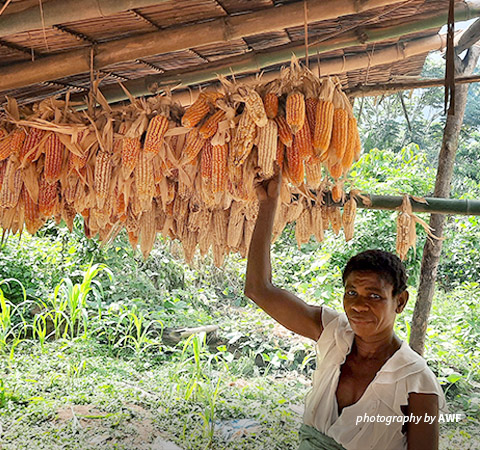Deadly drought in Africa exposes need to build climate resilience

More than 70 elephants have succumbed to prolonged drought in Kenya's Tsavo landscape in the last nine months
In 2022, it is a mistake to speak about the effects of climate change in the future tense. We are living through climate change-induced emergencies right now in the form of extreme weather shifts.
For four years in a row, the Horn of Africa has failed to receive a life-giving rainy season. The drought in Kenya, Somalia, Djibouti, and Ethiopia is the worst in 40 years and has threatened an estimated 20 million people with hunger. Shrinking harvests in the last few months are compounded by the high cost of fuel, increased production costs, business sector declines induced by the pandemic, and insufficient imports — of food itself and agricultural inputs like fertilizer — due to the war in Ukraine. A perfect storm of inflation and decreased supply have skyrocketed food prices, making it harder for families to put food on the table.
As of February, the drought had already killed over 1.5 million livestock in the region. In parts of Kenya, the crop harvest is down as much as 70 percent below average. The decimation of agriculture has impacted livelihoods and families’ direct source of food.

During dry seasons in the Tsavo landscape, herders graze their livestock in wildlife areas
The prolonged drought has been destructive for wildlife as well. In Kenya’s Tsavo ecosystem, 78 elephants have died from the drought since last July. Over just two months, rangers counted at least 10 baby elephant carcasses. The wildlife authority has also seen a significant uptick in poaching and illegal bushmeat hunting, with a 300 percent increase in the number of snares retrieved towards the end of 2021.
“High bushmeat poaching, [evidenced by] snaring and the number of arrests, can be attributed to drought as farms had nothing to reap,” says Amos Muthiuru, African Wildlife Foundation’s Species Conservation Assistant in Tsavo, illuminating the interdependence of human well-being and wildlife conservation. “The cycle of poaching is based on weather too. High drought, high poaching… and vice versa.”

Baby elephants are especially vulnerable to the loss of adult elephants
Human-wildlife conflict increases during severe droughts like this one. Water and vegetation scarcity lead wildlife to wander onto farmland — creating a danger both for people, whose lives and livelihoods could be trampled, and wildlife, who are sometimes killed in retaliation or defense. African elephants, for example, are a major concern because of their size and endangerment status.
Elephant calves are dying from the drought and are also being orphaned. Baby elephants cannot fend for themselves when separated from their mothers. Sometimes the calves are left behind when they get stuck in the wells their herds dig for water — which have had to be dug deeper and deeper during the drought.
Thankfully, parts of the Tsavo ecosystem are beginning to see rains, bringing some respite. But a return to the average rainy season will not reverse all of the damage from years of drought.
A downward spiral of climate failures
We can no longer focus only on preventing the worst effects of global warming and biodiversity loss. Building resilience in communities and protected areas is critical so that they can weather the shocks like the severe lack of rainfall or even flash floods experienced in South Africa in April, which killed hundreds of people.
Rather than reacting to the climate crisis by addressing the symptoms, we must invest in climate emergency preparedness and curb global emissions dramatically to stymy global warming at 1.5 degrees Celsius. Unfortunately, today’s extreme weather events — and resultant crises such as famine and displacement — are the outcomes of investments we failed to make decades ago.
Breaking the cycle with nature-based solutions
It has never been clearer that Africa is among the continents hit hardest by climate change, yet Africans only contribute 4 percent of global carbon emissions. Comprehensive investment in climate resilience in Africa and the Global South by countries with disproportionate carbon footprints must be coupled with a hardline commitment to curbing emissions.

AWF trains forest communities in Cameroon to use sustainable farming practices to improve yields
AWF is committed to building and advocating for these kinds of strategies. For example, improving water access and planning water use with local input mitigates crop failure and ensures that humans and wildlife do not have to compete for water. Installing beehive fences and planting chili peppers keeps elephants and other wildlife away from crops. At the same time, we work with local groups to develop conservation-friendly livelihood alternatives like the processing of non-timber forest products and sustainable cocoa farming, keeping Cameroon’s forest habitats intact and improving the economic stability of people living in biodiversity hotspots.
Protected area conservation in general has a significant impact on the ecosystems that are threatened by climate change. African rainforests are critical – the Congo Basin has recently been found to be a stronger carbon sink than even the Amazon.
The interdependence of wildlife, land, and human well-being
This drought is putting the Horn of Africa at a crossroads. Healthy, biodiverse ecosystems provide vital services for people. For that reason, a comprehensive climate response that centers the well-being of people must focus on nature as well. All threats to wildlife — drought, flooding, habitat loss, and human-wildlife conflict — are intertwined around the strategic use of land and water, human health, and the economy. The choices we make about our natural resources will have massive ripple effects on biodiversity protection, sustainable development, and the well-being of all amid a warming planet.
Across the world, young people are contending with a future where global warming gets worse before it can get better. Yet, despite the bleak outlook, we have a responsibility not to lose hope. Already, investments in African conservation and sustainable development are delivering significant impacts. We only need to scale this work up and build a broad coalition for a just, sustainable future.